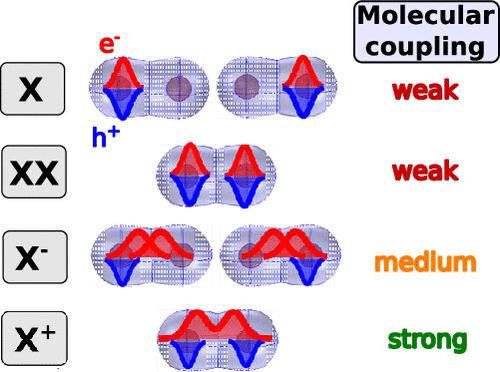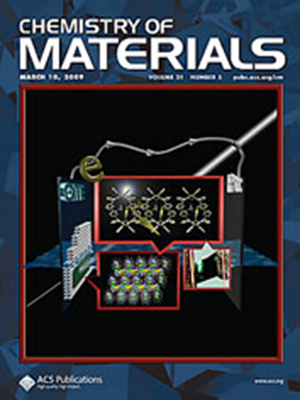三离子激发胶体量子点分子中的电子耦合
IF 7.2
2区 材料科学
Q2 CHEMISTRY, PHYSICAL
引用次数: 0
摘要
最近的合成进展使得胶体 CdSe/CdS 量子点的可控融合成为可能,从而形成二聚体,并在其光学响应中表现出电子耦合。虽然这种 "人造 H2 分子 "是纳米晶体化学发展的一个里程碑,但事实证明耦合的强度比预期的要小。原因在于,当系统中的激子被光诱导时,空穴会定位在硒化镉核心内部并俘获电子,这往往会阻止二聚体之间的大量脱ocal。在这里,我们通过 k-p 理论和构型相互作用计算预测,使用三子而不是中性激子或双激子可以恢复电子外迁。正三元子尤其合适,因为其强大的空穴-空穴斥力使电子跃迁在核心存在适度不对称的情况下也能保持稳定,从而维持类似同二聚体的行为。杂化能量大到足以在低温条件下保持分子特性。本文章由计算机程序翻译,如有差异,请以英文原文为准。

Trions Stimulate Electronic Coupling in Colloidal Quantum Dot Molecules
Recent synthetic progress has enabled the controlled fusion of colloidal CdSe/CdS quantum dots in order to form dimers, manifesting electronic coupling in their optical response. While this “artificial H2 molecule” constitutes a milestone toward the development of nanocrystal chemistry, the strength of the coupling has proven to be smaller than intended. The reason is that, when an exciton is photoinduced in the system, the hole localizes inside the CdSe cores and captures the electron, often preventing substantial delocalization across the dimer. Here, we predict, by means of k·p theory and configuration interaction calculations, that using trions instead of neutral excitons or biexcitons restores the electron delocalization. Positive trions are particularly apt because the strong hole–hole repulsion makes electron delocalization robust against moderate asymmetries in the cores, thus maintaining a homodimer-like behavior. The hybridization energies are sufficiently large to preserve the molecular character beyond cryogenic temperatures.
求助全文
通过发布文献求助,成功后即可免费获取论文全文。
去求助
来源期刊

Chemistry of Materials
工程技术-材料科学:综合
CiteScore
14.10
自引率
5.80%
发文量
929
审稿时长
1.5 months
期刊介绍:
The journal Chemistry of Materials focuses on publishing original research at the intersection of materials science and chemistry. The studies published in the journal involve chemistry as a prominent component and explore topics such as the design, synthesis, characterization, processing, understanding, and application of functional or potentially functional materials. The journal covers various areas of interest, including inorganic and organic solid-state chemistry, nanomaterials, biomaterials, thin films and polymers, and composite/hybrid materials. The journal particularly seeks papers that highlight the creation or development of innovative materials with novel optical, electrical, magnetic, catalytic, or mechanical properties. It is essential that manuscripts on these topics have a primary focus on the chemistry of materials and represent a significant advancement compared to prior research. Before external reviews are sought, submitted manuscripts undergo a review process by a minimum of two editors to ensure their appropriateness for the journal and the presence of sufficient evidence of a significant advance that will be of broad interest to the materials chemistry community.
 求助内容:
求助内容: 应助结果提醒方式:
应助结果提醒方式:


